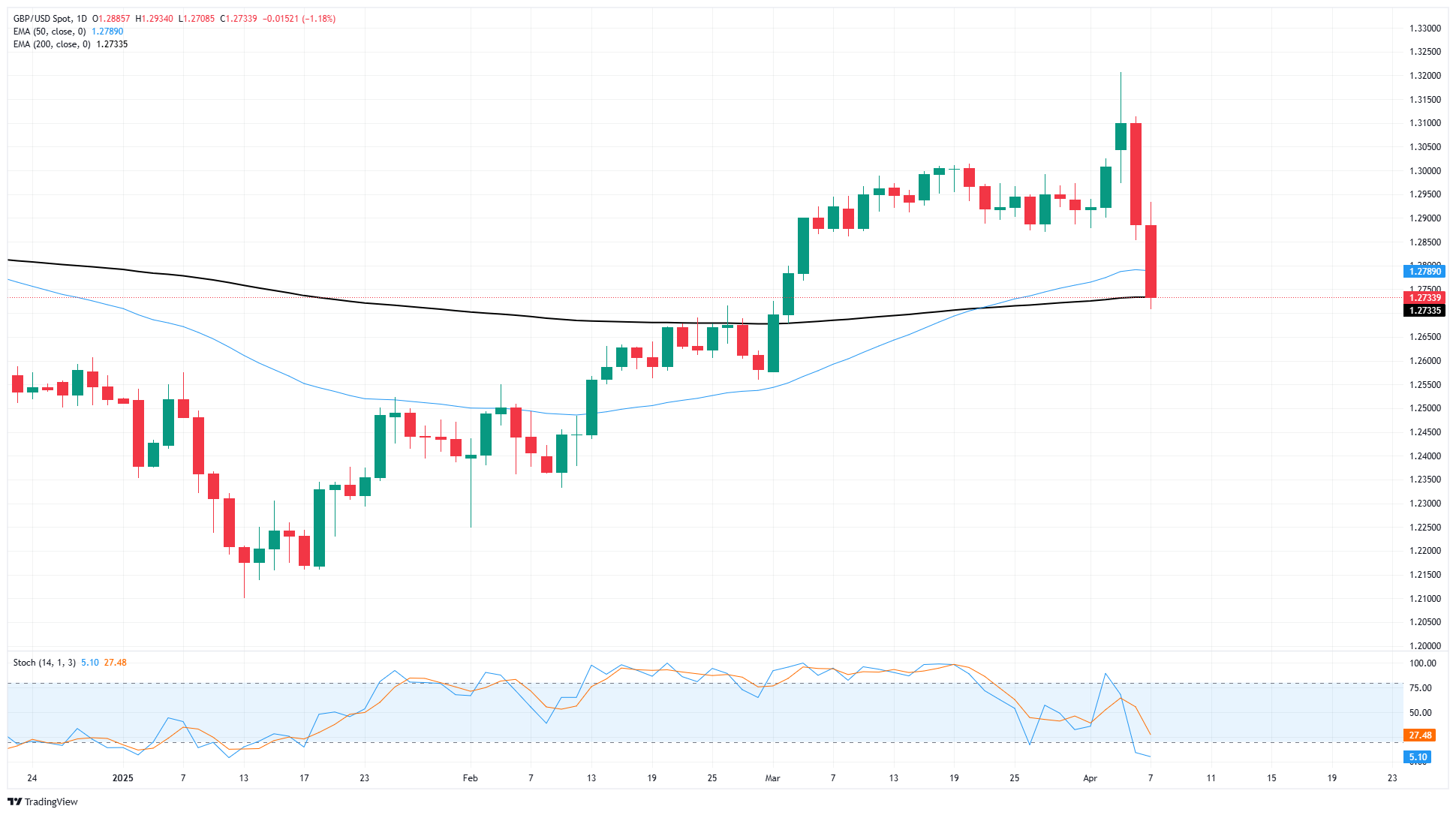- GBP/USD tumbled 1.2% on Monday, falling below 1.2750.
- Greenback safe haven flows have resumed after a brief pause.
- Investor sentiment continues to sour as Donald Trump threatens even more tariffs.
GBP/USD sank again on Monday, extending Cable into a second straight trading day of declines and pushing bids back down to the 200-day Exponential Moving Average (EMA) just north of 1.2700. After a brief reprieve, The US Dollar has resumed dominating risk-off flows, with deflating investor sentiment bolstering the Greenback across the board.
More tariffs? More tariffs.
After a tense week that saw the US pivot fully into a protectionist trade stance (but without the industry infrastructure to back it up), widespread import tariffs are on the books, with the US charging a flat 10% import tax on all goods from all countries, as well as widely-varied “reciprocal” tariffs that were derived by dividing US imports by US exports. After imposing an additional 34% tariff on Chinese goods, China clapped back with a retaliatory 34% tariff of its own on all goods bound from the US. Lacking any other means of problem-solving, the Trump administration has threatened to impose an additional 50% tariff on all Chinese goods, set to take effect on April 8.
Forex Today: Trump’s tariffs remain in centre stage ahead of US CPI
US data once again comes front and center this week; US Consumer Price Index (CPI) inflation figures are slated for Thursday, with US Producer Price Index (PPI) inflation and University of Michigan (UoM) Consumer Sentiment Index survey results are both set to publish on Friday. This will be the last blast of key US inflation and sentiment figures from the ‘pre-tariff’ phase of 2025, marking a key measurement metric for the remainder of the calendar year.
According to the CME’s FedWatch Tool, investors are piling back into bets that the Federal Reserve (Fed) will begin cutting interest rates to head off a recession. Rate markets are pricing in nearly 200 bps in interest rate cuts through the remainder of 2025, despite the Fed’s ongoing middling policy speeches warning that trade uncertainty makes it harder, not easier, for the Fed to trim rates.
GBP/USD price forecast
GBP/USD has declined nearly 4% peak-to-trough from last week’s peak bids just above the 1.3200 handle. A sharp rebalancing of market flows has dragged Cable back into the 200-day EMA, forcing bids back into a midrange that has plagued the pair for over two years.
Volatility is on the rise across the board, making technical levels difficult to identify. A rough resistance zone is priced in between 1.2900 and 1.3000, while the immediate technical floor is priced in from 1.2600.
GBP/USD daily chart

Pound Sterling FAQs
The Pound Sterling (GBP) is the oldest currency in the world (886 AD) and the official currency of the United Kingdom. It is the fourth most traded unit for foreign exchange (FX) in the world, accounting for 12% of all transactions, averaging $630 billion a day, according to 2022 data. Its key trading pairs are GBP/USD, also known as ‘Cable’, which accounts for 11% of FX, GBP/JPY, or the ‘Dragon’ as it is known by traders (3%), and EUR/GBP (2%). The Pound Sterling is issued by the Bank of England (BoE).
The single most important factor influencing the value of the Pound Sterling is monetary policy decided by the Bank of England. The BoE bases its decisions on whether it has achieved its primary goal of “price stability” – a steady inflation rate of around 2%. Its primary tool for achieving this is the adjustment of interest rates. When inflation is too high, the BoE will try to rein it in by raising interest rates, making it more expensive for people and businesses to access credit. This is generally positive for GBP, as higher interest rates make the UK a more attractive place for global investors to park their money. When inflation falls too low it is a sign economic growth is slowing. In this scenario, the BoE will consider lowering interest rates to cheapen credit so businesses will borrow more to invest in growth-generating projects.
Data releases gauge the health of the economy and can impact the value of the Pound Sterling. Indicators such as GDP, Manufacturing and Services PMIs, and employment can all influence the direction of the GBP. A strong economy is good for Sterling. Not only does it attract more foreign investment but it may encourage the BoE to put up interest rates, which will directly strengthen GBP. Otherwise, if economic data is weak, the Pound Sterling is likely to fall.
Another significant data release for the Pound Sterling is the Trade Balance. This indicator measures the difference between what a country earns from its exports and what it spends on imports over a given period. If a country produces highly sought-after exports, its currency will benefit purely from the extra demand created from foreign buyers seeking to purchase these goods. Therefore, a positive net Trade Balance strengthens a currency and vice versa for a negative balance.
Information on these pages contains forward-looking statements that involve risks and uncertainties. Markets and instruments profiled on this page are for informational purposes only and should not in any way come across as a recommendation to buy or sell in these assets. You should do your own thorough research before making any investment decisions. FXStreet does not in any way guarantee that this information is free from mistakes, errors, or material misstatements. It also does not guarantee that this information is of a timely nature. Investing in Open Markets involves a great deal of risk, including the loss of all or a portion of your investment, as well as emotional distress. All risks, losses and costs associated with investing, including total loss of principal, are your responsibility. The views and opinions expressed in this article are those of the authors and do not necessarily reflect the official policy or position of FXStreet nor its advertisers. The author will not be held responsible for information that is found at the end of links posted on this page.
If not otherwise explicitly mentioned in the body of the article, at the time of writing, the author has no position in any stock mentioned in this article and no business relationship with any company mentioned. The author has not received compensation for writing this article, other than from FXStreet.
FXStreet and the author do not provide personalized recommendations. The author makes no representations as to the accuracy, completeness, or suitability of this information. FXStreet and the author will not be liable for any errors, omissions or any losses, injuries or damages arising from this information and its display or use. Errors and omissions excepted.
The author and FXStreet are not registered investment advisors and nothing in this article is intended to be investment advice.
Recommended content
Editors’ Picks

AUD/USD: Buyers retake 0.6350 after Chinese GDP data
AUD/USD picks up fresh bids and retakes 0.6350 in Asian trading on Wednesday. The pair finds fresh demand after Chinese Q1 GDP beat estimaes with 5.4% YoY while Retail Sales and Industrial Production data also exceeded expectations. However, the further upside could be capped by US-China trade woes ahead of Powell.

Gold price hangs close to all-time highs at $3,275
Gold price holds the advannce to record another all-time high at $3,275 per troy ounce in the Asian session on Wednesday. Safe-haven demand amid US President Donald Trump's uncertain tariff plans, softer US Dollar and prospects of further easing by the Federal Reserve provide some support to the yellow metal.

USD/JPY stays pressured toward 142.50 amid renewed US Dollar selling
USD/JPY turns south toward 142.50 and remains close to a multi-month low touched last week. Tariff-driven uncertainty continued to weigh on the US Dollar. Adding to this hope for a US-Japan trade deal, the divergent BoJ-Fed policy expectations and a softer risk tone underpin the safe-haven Japanese Yen.

Binance and KuCoin traders panic as Amazon Web Service outage halts Crypto withdrawals
On Monday, a technical outage from Amazon Web Services temporarily halted operations at top cryptocurrency exchanges, including Binance and KuCoin. The outage disrupted withdrawals and trading services, sparking major concerns among cryptocurrency traders.

Is a recession looming?
Wall Street skyrockets after Trump announces tariff delay. But gains remain limited as Trade War with China continues. Recession odds have eased, but investors remain fearful. The worst may not be over, deeper market wounds still possible.

The Best brokers to trade EUR/USD
SPONSORED Discover the top brokers for trading EUR/USD in 2025. Our list features brokers with competitive spreads, fast execution, and powerful platforms. Whether you're a beginner or an expert, find the right partner to navigate the dynamic Forex market.



